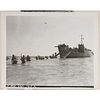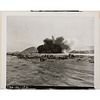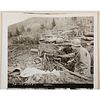WWII "Operation Dragoon" Army Signal Corps Photograph Album Containing Over 650 Images
About Seller
6270 Este Ave.
Cincinnati , OH 45232
United States
With offices in Cincinnati, Cleveland and Denver, Cowan’s holds over 40 auctions each year, with annual sales exceeding $16M. We reach buyers around the globe, and take pride in our reputation for integrity, customer service and great results. A full-service house, Cowan’s Auctions specializes in Am...Read more
Two ways to bid:
- Leave a max absentee bid and the platform will bid on your behalf up to your maximum bid during the live auction.
- Bid live during the auction and your bids will be submitted real-time to the auctioneer.
Bid Increments
| Price | Bid Increment |
|---|---|
| $0 | $25 |
| $500 | $50 |
| $1,000 | $100 |
| $2,000 | $250 |
| $5,000 | $500 |
| $10,000 | $1,000 |
| $20,000 | $2,500 |
| $50,000 | $5,000 |
| $100,000 | $10,000 |
About Auction
Jun 26, 2020
Cowan's Auctions is delighted to present the June 26 American Historical Ephemera and Photography Auction, including 55 lots devoted to the African American experience, over 175 lots dating from the Civil War Era, and more than 60 lots documenting life in the American West. Cowan's Auctions dawnie@cowans.com
- Lot Description
WWII "Operation Dragoon" Army Signal Corps Photograph Album Containing Over 650 Images
Album, 12 x 14.75 in., containing 650+ silver gelatin photographs, each approx. 4 x 5 in., with 18 photographs affixed to front of each album page. The photographs were taken by Lieutenant West, a member of the Army Signal Corp and depict events leading up to France's second D-Day "Operation Dragoon," the Allied invasion led by US General Patch. The photos are explicitly identified by date, location and event starting on July 24, 1944 thru January 25, 1945. They include photos of the build up to the August 15th invasion, German prisoners of war, liberation, Generals Patton & Patch photo, Nazis, Dachau horror, dead Germans, artillery, tanks, aircraft and so much more history as it unfolded. Plus 80 photographs taken with a civilian camera, many of West in front of landmarks (St. Peter's Cathedral, Notre Dame, Eiffel Tower, Sphinx, Pyramids, etc.) as he traveled the world with the Army (he is always in uniform). Join the Army, see the World.
One group of images shows Lt. Col. West at his desk, receiving a bronze star from Lt. Gen. Wade Haislip, and several groups of 7th Army officers and aides (his driver, for example) with West. Many of these group shots have been signed by the subjects of the images.
Initially designated "Operation Anvil" (to go along with "Operation Sledgehammer"), the working nicknames that eventually became "Operation Dragoon" and "Operation Overlord," this invasion was intended to open France's Mediterranean ports, especially Marseille and Toulon. The two were intended to happen at the same time, but the Allies realized that there was not enough resources, especially hardware such as landing ships (LSTs), to cover both operations simultaneously. After the successful landing at Normandy, the Atlantic ports became so clogged with ships trying to supply the Allied forces, that the Chiefs of Staff dusted off the plans for the Provence invasion and Operation Dragoon was planned for August 15, 1944. The invasion basically proceeded as planned, and the German units in the area retreated up the Rhone Valley and set up a front at Dijon. While the German forces suffered significant damage, unfortunately the best units were able to escape more or less intact, so German Army Group G was able to hold Dijon for several weeks. Eventually the Normandy invasion forces met the Provence invasion forces in mid-September and they were able to continue pushing German forces out of France. The Mediterranean ports were soon made operational and the Allies were able to solve many of their supply problems. - Shipping Info
-
Buyers are required to pay for all packing, shipping and insurance charges. Overseas duty charges are the responsibility of the successful Bidder. Be aware that for larger and/or valuable items, shipping charges can be substantial. - If there is no shipping amount on listed your invoice, you will need to make arrangements to pick up or ship your purchase through an alternative shipping company. Our shipping department can be contacted at 513.871.1670 (ext. 219) or email shipping@cowans.com. - Shipping charges include insurance for your order while in transit. If you have private insurance we will adjust your charge to include only packing and shipping. - Please allow 14 – 21 days after payment to package and ship your purchase as carefully as possible.
-
- Buyer's Premium



 EUR
EUR CAD
CAD AUD
AUD GBP
GBP MXN
MXN HKD
HKD CNY
CNY MYR
MYR SEK
SEK SGD
SGD CHF
CHF THB
THB
























